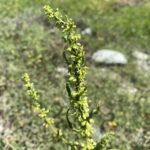Αλαπαθκιά, Λάπαθο το οδοντωτό υποείδος το μεσοποτάμειο
Etymology of Rumex dentatus subsp. mesopotamicus
"Rumex" was named after Pliny; Rumex means "javelin or spear", due to the pointed shape of the leaves of many species of this genus. The name "dentatus" come from the Latin adjective dentatus, which means "toothed." It refers to the characteristic toothed margins of the inner fruiting valves (tepals) of this species. The Latin word dens (genitive dentis) means "tooth." This subspecies epithet is derived from Mesopotamia, the historical region situated in Western Asia within the Tigris–Euphrates river system, in modern-day Iraq, Kuwait, and parts of Syria and Turkey. The suffix -icus is a Latin suffix meaning "belonging to" or "related to." Therefore, mesopotamicus indicates that this subspecies is native to or characteristic of the Mesopotamia region.
Rumex of Cyprus
At least 15 Rumex species and subspecies have been identified so far in Cyprus, of which one subspecies is exclusively growing in occupied Cyprus.
Rumex dentatus subsp. mesopotamicus, appears at low altitudes, up to 175 meters, in southern and eastern Cyprus. It primarily grows in moist areas. Its flowering period is between April and July.
How to identify the Rumex dentatus species
Here are potential unique features of Rumex dentatus subsp. mesopotamicus that likely differentiate it from other Rumex species and possibly other subspecies of R. dentatus:
Annual Habit and Size
Rumex dentatus is typically described as an annual plant, often relatively short, reaching 20-70 (-80) cm in height. This annual life cycle and moderate size can distinguish it from perennial and often larger Rumex species.
Inflorescence
The inflorescence of Rumex dentatus species is a terminal, often lax and interrupted, broadly paniculate structure occupying the distal half of the stem. The branches are usually ascending and straight. The subspecies Rumex dentatus subsp. mesopotamicus has an inflorescence that is simple and spiciform, or with lax, erect or ascending branches, not spreading branches, which is a key differentiator from other Rumex with more complex or spreading panicles. A spiciform inflorescence means that it is similar to the shape of a spike but, unlike it, has small pedicels on the base of each flower.
Fruiting Valves (Inner Tepals)
The inner tepals (fruiting valves) of Rumex dentatus are ovate-triangular or deltoid, with a truncate base and a distinctly dentate margin, bearing 2-4 (-5) narrowly triangular teeth on each side. The teeth are typically equal to or shorter than the width of the inner tepals. The valves of Rumex dentatus subsp. mesopotamicus valves are 3-4 mm wide.
Teeth
The teeth are at least 1 mm long.
Pedicels
The fruiting pedicels are terate, 2-5 mm long, and articulated in the proximal 1/3 with a distinctly swollen articulation. Terate is a structure that is cylindrical and smooth or rounded in cross-section, lacking distinct angles or ridges.





